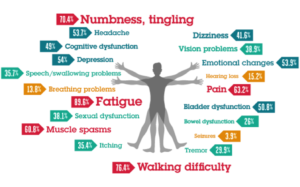Ok, you get it, exercise is good for your body. From lowering blood pressure to improving your mental health, there is so much information thrown at you about the benefits these days!
In the past, people with Multiple Sclerosis (MS) have been advised to avoid exertion. For the 99% of people not living with MS, this is completely fine, although for individuals with MS, this can be risky as the symptoms they experience with exertion are amplified as their temperature rises. Historically, and as a direct consequence, health professionals believed it was best to avoid exercise completely.
These days, more recent studies indicate that aerobic activity is not only safe, but actually improves many of the symptoms related to the disease (indicated in the graphic below). Furthermore, exercise also helps to prevent cognitive decline and it is proven that movement actually has a more positive effect on spasms than stretching.

No doubt you’ve heard sayings like “no pain, no gain” or “feel the burn.” Well, although they may be applicable to 90% of the population, this is not sound advice to follow for those living with MS. Some people believe that if you push yourself so hard that it hurts, then it must be doing you good. Trust me when I say that, if you spend more time recovering from an activity and feeling sore rather than reaping the benefits (improved energy and increased strength) then the balance is not quite right
Where to start:
Regardless of whether you’re living with MS or not, my first piece of advice is to find a type of exercise or activity that you actually enjoy doing. Whether it be exercise in a group setting or going on a 12k hike (all the power to you if that’s your thing) it’s all about finding something that you want to do.
Lift some stuff
Sessions with free weights or a machine will build muscle strength. Studies show that if you stick with a regular, resistance based routine for up to 8 weeks, you’ll build muscle, walk better and feel less fatigued.
Just dive in
Unless you physically can’t swim (and in that case please ignore this suggestion) go and take a dip! Do a few laps or try doing a couple of exercises underwater. Having your lower body submerged is not only much easier on your joints but the buoyancy of the water will help you out if you have difficulty walking or have any stability issues.
Be ‘zen’
Yoga, with its variety of poses, some easy and some not so easy is a great way to improve your flexibility and range of motion. Yoga also = happiness (literally). It’ll reduce your cortisol levels (pesky little stress hormone) and promote an overall sense of calmness.
Cardi-no? Cardio-yes?
Whether it be a 10 minute walk on the treadmill or a brisk journey around the neighbourhood with your bestie to pick up a latte, anything that raises your heart rate is a positive. If you tire easily, split up your workout into 2-5 minute periods with rests in between. You’ll still reap the benefits.
Get your balance
Since MS can impact the cerebellum; the part of your brain that controls balance. Introducing a stability ball into your workout is a great idea. It makes basic exercises even more challenging in an attempt to train not only your muscles but your brain.
Before you get moving:
Keep it cool
As mentioned above exercise can cause you to overheat and trigger symptoms such as increased fatigue, blurry vision and muscle weakness, so remember to stay hydrated (with water and sugar-free electrolytes). Other ways to control your body temp is to avoid midday workouts and take regular breaks.
Touch your toes (or attempt to)
5-10 minutes is all you need before you start exercising, in order to help boost circulation and prevent injury. I’m not saying you have to be hard-core and sit there in pretzel like positions, but simple movements such as swinging your arms around and reaching down towards your toes are a go-to.
Be aware
If it’s been a while since your last bout of exercise, take it easy. Start off slow, use smaller weights with lower repetitions and work your way up, bit-by-bit. When you first start a program, begin with exercise you know you can perform gradually build on them.
Just Breathe
One tip that sounds simple, though is often overlooked – don’t forget to breathe. You laugh now but I assure you that holding your breath is not as uncommon as you think.
Lastly, be patient. As determined and enthusiastic as you are, you won’t see results over night. Just focus on the task at hand and set yourself small, achievable goals. By the end, I hope that you’ll view exercise as something that you enjoy doing and not something that you feel like you have to do.
References:
Abs.gov.au (2017). 4429.0 – Profiles of Disability, Australia, 2009. Available at:
http://www.abs.gov.au/ausstats/abs@nsf/Lookup/4429.)Main+Features100182009
Asano, M. and Finlayson, M. (2014). Meta-Analysis of Three Different Types of Fatigue Management Interventions for People with Multiple Sclerosis: Exercise, Education, and Medication. Multiple Sclerosis International, 2014, pp.1-12.
Managing Multiple Sclerosis. (1998). Multiple Sclerosis Journal, 4(5), pp.453-465.
Msaustralia.org.au (2017). Exercise & Activity | MS Australia. Available at: https://www.msaustralia.org.au/wellbeing-ms/exercise-activity
Wiggins, M., Rader, E. and Erdmann, J. (2007). Exercise Benefits for Multiple Sclerosis Participant: Case Study. International Journal of MS Care, 9(3), pp.126-130.
Willingham, E. (2014). MS Patient, Ph.D.: Exercise in MS: Good or Bad? Multiple Sclerosis Discovery Forum.
